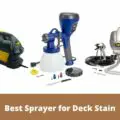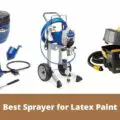Sprayer
Best Sprayer for Cabinets
The Best Paint Sprayers for Cabinets in 2022
There’s a case to be made for investing in any of the best paint sprayers for cabinets in 2022. At first, I didn’t see the need for one either. I had paint brushes and rollers, and they did the job every time. Why would anyone need a paint sprayer to paint cabinets?
Within the first few minutes of using a paint sprayer, you immediately know you’re never returning to brushes and rollers. For starters, getting a silky smooth finish is much easier because there aren’t any bristles to leave brush marks. It also consumes very little paint compared to brushes and rollers.
But what caught me completely off-guard is how fast it gets the job done! The way it allows you to control the thickness of each coat gives you the confidence to produce professional results.
It’s easy to figure out what you need in a paint sprayer. Here are some things that matter when selecting a tool for spray painting cabinets.
Buying Guide for Paint Sprayers
Types of Spraying Systems
These are the four types of spraying systems you’ll encounter on your search:
Compressed Air Paint Sprayer
All you need to know about this sprayer is that it’s the traditional model. It’s basically a spray gun attached to a pressurized canister with a high-pressure hose.
A compressed air paint sprayer typically costs over a thousand dollars. It is also more difficult to operate since it produces a lot of oversprays. However, it became my go-to for creating smooth, professional finishes once I figured out how to control it.
Testing out different nozzles is a rite of passage with the conventional paint sprayer. Once you find the attachments that optimize the flow and pattern of the spray, you’ll create much more pleasant results.
High-Volume Low-Pressure Paint Sprayer (HVLP)
HVLP sprayers have a small electric turbine that compresses air to spray paint. You can buy one of these for less than $100. The downside to using these is that they spray much slower than compressed air paint sprayers. If you have a huge project, steer clear of these as they might be inadequate.
For small cabinet repainting jobs, however, they’re excellent. HVLP paint sprayers are very economical because they produce very little overspray. Consequently, that makes them much easier to control. I would always use my HVLP, but I often reached for the compressed air painter because it creates smoother finishes.
Low-Volume Low-Pressure Paint Sprayer (LVLP)
An LVLP paint sprayer is like a less powerful compressed air paint sprayer. The configuration is identical: it comprises a spray gun attached to a pressurized tank via a hose. The difference is that these work with less powerful air compressors.
Like HVLP sprayers, LVLPs have a smaller spray pattern and may not be the best solution for large projects. Nevertheless, they are very precise; it’s easy to control the spray pattern since there’s almost no overspray. Unfortunately, it’s not too compatible with thicker paints since it sprays at very low pressures.
Airless Paint Sprayers
Airless paint sprayers propel paint using only an electric turbine. Curiously, these types of sprayers can manage up to 3,000 PSI, making them the most powerful of the lot. I favor airless sprayers when I need to do a job quickly because they spray thick coats. Ultimately, they work the fastest and come with different tip sizes to create varying spray patterns.
Even though I’ve found the extra power handy for large projects, it does come with a lot of oversprays. This is certainly not the paint sprayer you want to start with if you’re not too familiar with how they’re operated.
However, if you’re looking to tackle large painting projects quickly, look no further than this. To produce a smooth finish, you’ll need to maintain a 12-inch buffer between the tip and the cabinet. Also, you may want to invest in different sizes, such as a 311, which is better for finishing cabinets.
Size of the Spraying Tip
If you buy an airless painter, I recommend getting a few tips of different sizes. Airless painters utilize tips to diffuse the paint so that you can manage the size and shape of the spray pattern. In contrast, an HPLV sprayer has an adjustable cap that lets you regulate the spray pattern and size.
Ease of Use
HPLV painters are the easiest to use and the most affordable. It makes sense to start here and work your way up. It creates very little overspray and sprays with admirable precision. Also, they’re cheaper since you don’t need to purchase a separate air compressor.
In contrast, airless painters are much more powerful and expensive, even though they’re harder to control. Rather than cabinets, I use them for sizeable projects like painting a fence or re-doing my home exterior.
Project Size
Repainting cabinets using a paint sprayer is almost enjoyable if you get enough tools for the job. Diving headfirst into their airless category might be overkill if you only have a couple of cabinetry sets to paint.
However, if your project extends beyond painting cabinets, it’s more sensible to buy a painter that can quickly handle relatively large projects. Consider LPLV if you’re more worried about adjusting the output volume and managing the spray pattern.
Power Method
Spray painters can be manual or electric. Compressed air and LPLV painters have manual systems, whereas HPLV and airless spray painters are powered by electric motors.
The power method doesn’t determine the tool’s output since conventional sprayers are much more powerful than electric HPLV sprayers. What matters more is the volume of paintwork and your level of expertise in handling spray painters.
Variable Pressure
Some sprayers have controls that allow you to tweak the amount of pressure to achieve different spray patterns and sizes. I find these handy in minimizing tails and fingers (the result of low-pressure spraying) while keeping overspray in check.
If you can afford it, get a tool with a variable pressure setting. It will give you much more versatility in terms of the shape and type of spray pattern you can use.
Why You Should Trust Us
At Woodworking Tool Guide, we know one size doesn't fit all! We cater to every woodworker, from beginner to pro, with insights and recommendations tailored to your skill level, project needs, and budget. We take the guesswork out of choosing the right tools, whether you're tackling your first crafting a masterpiece for the ages. So grab your chisel, join our community, and let's build something amazing together!
Woodworking Tool Guide wasn't just born, it sprouted from a seed of passion for the craft. What started as a joyful exploration blossomed into a trusted online haven for fellow enthusiasts like you. We pour our love into meticulously chosen review selections, meticulous hands-on testing, and lab-backed insights, all to empower you with reliable, comprehensive information you can build on. So, grab your tools, trust our guidance, and let's build something beautiful together!
Passion-Driven Expertise
Our journey started with a shared love for woodworking. The team behind the Woodworking Tool Guide is comprised of individuals who are not just writers but passionate woodworkers themselves. This shared enthusiasm ensures that our content is crafted with a deep understanding of the craft and an authentic appreciation for quality tools.
Top Tool Guides Online
Woodworking Tool Guide has rapidly ascended to become one of the premier online destinations for tool guidance. Our commitment to excellence and the accuracy of our information has positioned us as a reliable source for both beginners and seasoned woodworkers seeking trustworthy advice on the best tools for their projects.
User-Centric Approach
Our content caters to every woodworker, from rookies just starting out to seasoned pros tackling intricate projects. We tailor our insights and recommendations to your skill level, project needs, and budget, ensuring you find the perfect tools to match your unique woodworking journey. So step into your workshop, grab your tool belt, and let Woodworking Tool Guide be your trusted companion as you craft your masterpieces.
Continuous Support and Innovation
Woodworking is an ever-evolving craft, and so is our commitment to supporting you. We are dedicated to bringing you the latest information on woodworking tools, techniques, and trends. Our team is actively working to expand our content and bring you more valuable insights, ensuring that you stay well-informed in your woodworking adventure.
Hands-On Experience
Ditch the endless research rabbit hole! At Woodworking Tool Guide, we believe in actionable advice, not armchair analysis. We get our hands dirty, putting every tool through its paces in real-world woodworking scenarios. Whether it's the precision of a table saw, the versatility of a router, or the tactile satisfaction of a handplane, we test for performance, durability, and user-friendliness. No more sifting through dry specs – we deliver practical insights you can trust to transform your woodworking dreams into reality.
Woodworking Tool Guide isn't just a review site, it's your trusted companion on the sawdust-filled path to woodworking mastery. Our expert team, led by veteran David Jones, meticulously tests and explains tools in terms you understand. We cut through the jargon, bias, and confusion with real-world insights and honest evaluations. Join our passionate community, where decades of experience, cutting-edge knowledge, and shared love for the craft come together to guide you every step of the way. So grab your chisel, buckle up, and let's embark on this exciting woodworking adventure, together!









